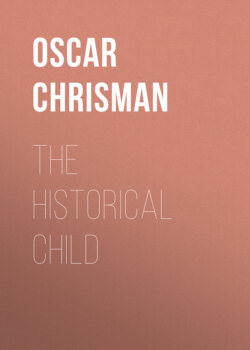Читать книгу The Historical Child - Oscar Chrisman - Страница 48
На сайте Литреса книга снята с продажи.
Education.
ОглавлениеTable of Contents
The ancient Egyptians were very much interested in the education of the young. It would appear that the parent was left entire freedom in the selecting what education and how much the child should have. In the matter of education there seemed to be no caste whatever, as the poor boy and son of one of the lower classes could take his place in school by the side of the rich boy or the son of the noble.
A clever boy in school had great opportunities, be he from whatever class of society. He was encouraged to go on to literary life, which meant, if successful, entering into the employ of the government and reaching the very highest places. Many a great nobleman so arose in Egypt and often was found on his monument after his death: "His ancestors were unknown people."
There were elementary schools, probably none provided by the state, and whether there were schools or not in a community, there were teachers to be had for the instruction of the young. With the temples were connected higher schools and in the capitals of the three districts of Egypt, Thebes, Memphis, Heliopolis, the temple schools were quite important centers of learning. The child started into the elementary school at near five years of age and continued till he left for work, or to enter a higher school, or else he might have gone into the office of a scribe or physician or architect to learn directly the work of his profession. The vast majority of the children received very little training beyond the rudiments of education and what instruction was given to them by their parents in teaching them their trades. Some of the young people continued with their schooling and entered the schools of the temples and there came in contact with the learned men of the state and received a higher education. A very few of these, who displayed special aptitude for learning, were permitted to enter into the deeper studies and to whom was thrown open all the knowledge possessed by the wisest men of their day. Little is known about the education of girls. As the women ranked high in Egypt and took part in the public festivities and religious ceremonies, they must have received such education as would prepare them for their duties in life.
The purpose of education in ancient Egypt was to prepare for some one of the callings of priest, scribe, architect, engineer, physician, soldier, musician, artisan. It was necessary to be educated to enter into office and to rise in position. Thus the education was of a utilitarian nature. The most important calling outside the priesthood was that of the scribe. The scribe learned about official documents and the management of business and to read and write the three forms of writing—hieroglyphic, hierotic, demotic—and also he studied ethics, philosophy, and law. The architect studied mathematics and science and the history that would give him a knowledge of art. The physician was taught such anatomy and physiology as was known, remedies and incantations, and other things pertaining to his calling. Whatever may be considered about this education, it did give Egypt a high place among the old nations of the world and caused its civilization to continue through many centuries.
In the home and in the school it was impressed on the children to be respectful to their elders. They were taught to be careful of looks and gestures, that such should be of a proper kind. It was not permitted to use any dance or ode at the feasts and sacrifices that had not been passed on by the proper authorities. The children were not permitted to hear or to learn any verses or songs than such as were of a virtuous giving character.
The discipline in school was quite severe. One teacher spoke thus: "The hawk is taught to fly and the pigeon to nest; I shall teach you your letters, you idle villain."49 A pedagogical saying runs: "A young fellow has a back, he hears when we strike it."
"Plato says the Egyptians taught numbers to children in their play by distributing amongst them a certain number of fruits, or other things, the same number to be given to many or to few children, so that by dividing them amongst themselves they learnt lessons in arithmetic; and all sorts of numbers were given to them in their games and plays as arithmetical problems."50
For written work they had wooden blocks covered with red or white stucco. Copies were engraved on wooden or stone tablets and then the children copied them on their tablets. Work was also given by dictation. The older pupils wrote from dictation, or from copies, extracts from the best writers. This trained also in penmanship and spelling. Often the pupils copied an "instruction," which consisted of moral precepts of an ancient writer. Often the instruction consisted of letters between student and teacher.
